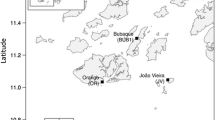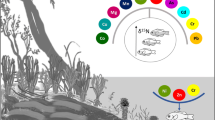Abstract
We report cadmium (Cd) concentrations in muscle, liver, and blood of striped marlin (Kajikia audax) and blue marlin (Makaira nigricans), caught in the southwest of the Gulf of California. The average Cd concentration was higher in the liver followed by blood and muscle in descending order. This pattern of Cd concentration may be related to the differences in the physiological function of these tissues. In K. audax, the Cd concentration in muscle and liver increased proportionally with body size, but only in animals that have reached the body size corresponding to first sexual maturity (animals exceeding 155 cm of postorbital length). Interspecific differences in dietary composition and Cd content evidenced that food preferences have a significant effect on the bioaccumulation of Cd. No evidence of Cd biomagnification (progressive bioaccumulation of an element along the food web) was found, as the correlation between logarithmic Cd concentrations and δ15N values was not significant when both billfish and their prey items were included in the calculations. Furthermore, the calculated biotransference factor (transfer of an element from food to consumer) suggested that Cd transference is interrupted from prey to marlins.





Similar content being viewed by others
References
Castro R, Durazo R, Mascarenhas A, Collins CA, Trasviña A (2006) Thermohaline variability and geostrophic circulation in the southern portion of the Gulf of California. Deep-Sea Res I 53:188–200
Páez-Osuna F, Álvarez-Borrego S, Ruiz-Fernández AC, García-Hernández J, Jara-Marini M, Bergés-Tiznado ME, Piñon-Gimate A, Alonso-Rodríguez R, Soto-Jiménez MF, Frías-Espericueta MG, Ruelas-Inzunza J, Green-Ruiz C, Osuna-Martínez CC, Sánchez-Cabeza JA (2017) Environmental status of the Gulf of California: a pollution review. Earth-Sci Rev 166:181–205
Soto-Jiménez MF, Amezcua F, González-Ledesma R (2010) Nonessential metals in striped marlin and Indo-Pacific sailfish in the southeast Gulf of California, Mexico: concentration and assessment of human health risk. Arch Environ Contam Toxicol 58:810–818
González-Armas R, Klett-Traulsen A, Hernández-Herrera A (2006) Evidence of billfish reproduction in the southern Gulf of California, Mexico. Bull Mar Sci 79:705–717
Torres-Rojas Y, Hernandez Herrera A, Ortega-García S, Domeier M (2013) Stable isotope differences between blue marlin (Makaira mazara) and striped marlin (Kajikia audax) in the southern Gulf of California, Mexico. Bull Mar Sci 89:421–436
Kojadinovic J, Pootier M, Le Corre M, Cosson RP, Bustamante P (2007) Bioaccumulation of trace elements in pelagic fish from the Western Indian Ocean. Environ Pollut 146:548–566
Endo T, Kimura O, Ogasawara H, Ohta C, Koga N, Kato Y, Haraguchi K (2015) Mercury, cadmium, zinc and copper concentrations and stable isotope rations of carbon and nitrogen in tiger sharks (Galeocerdo cuvier) culled off Ishigaki, Japan. Ecol Indic 55:86–93
Ruelas-Inzunza J, Soto-Jiménez MF, Ruiz-Fernández AC, Ramos-Osuna M, Montes-Saucedo J, Páez-Osuna F (2014) 210Po, Cd and Pb distribution and biomagnification in the yellowfin tuna Thunnus albacares and skipjack tuna Katsuwonus pelamis from the Eastern Pacific. Mar Pollut Bull 87:98–103
Amiard JC, Amiard-Triquet C, Metayer C, Marchand J, Ferre R (1980) Study on the transfer of Cd, Pb, Cu and Zn in neritic and estuarine trophic chains. I. The inner estuary of the Loire (France) in the summer of 1978. Water Res 14:665–673
Szefer P (1991) Interphase and trophic relationships of metals in a southern Baltic ecosystems. Sci Total Environ 101:201–215
Ruelas-Inzunza J, Páez-Osuna F (2008) Trophic distribution of Cd, Pb, and Zn in a food web from Altata-Ensenada del Pabellón subtropical lagoon, SE Gulf of California. Arch Environ Contam Toxicol 54:584–596
Jara-Marini ME, Soto-Jiménez MF, Páez-Osuna F (2009) Trophic relationships and transference of cadmium, copper, lead and zinc in a subtropical coastal lagoon food web from SE Gulf of California. Chemosphere 77:1366–1373
Popp BN, Graham BS, Olson RJ, Hannides CCS, Lott MJ et al (2007) Insight into the trophic ecology of yellowfin tuna, Thunnus albacares, from compound specific nitrogen isotope analysis of proteinaceous amino acids. In: Dawson T, Siegwolf R (eds) Stable isotopes as indicators of ecological change. Elsevier Academic Press, Terrestrial Ecology Series, USA, pp 173–190
Post DM (2002) Using stable isotopes to estimate trophic position: models, methods, and assumptions. Ecology 83:703–718
MacNeli MA, Drouillard KG, Fisk AT (2006) Variable uptake and elimination of stable nitrogen isotopes between tissues in fish. Can J Fish Aquat Sci 63:345–352
Cardona-Marek T, Knott KK, Meyer BE, O’Hara TM (2009) Mercury concentrations in Southern Beaufort Sea polar bears: variation base on stable isotopes of carbon and nitrogen. Environ Toxicol Chem 7:1416–1424
Páez-Osuna F, Tron-Mayén L (1995) Distribution of heavy metals in tissues of shrimp Penaeus californiensis from the Northwest coast of Mexico. Bull Environ Contam Toxicol 52:209–215
Zar JH (1999) Biostatistical analysis. Prentice-Hall Inc., Upper Saddle River
Kehring HA, Seixas TG, Malm O, Di Beneditto APM, Rezende CE (2013) Mercury and selenium biomagnification in a Brazilian coastal food web using nitrogen stable isotope analysis: a case study in an area under the influence of the Paraiba do Sul River plume. Mar Pollut Bull 75:283–290
Hoekstra PF, O’Hara TM, Fisk AT, Borga K, Solomon KR, Muir DCG (2003) Trophic transfer of persistent organochlorine contaminants (OCs) within an Artic marine food web from the southern Beaufort-Chukchi Seas. Environ Pollut 124:509–522
Storelli MM, Giacominelli-Stuffer R, Storelli A, Marcotrigiano GO (2005) Accumulation of mercury, cadmium, lead and arsenic in swordfish and bluefin tuna from the Mediterranean Sea: a comparative study. Mar Pollut Bull 50:993–1018
Heath AG (1995) Water pollution and fish physiology, 2nd edn. CRC Press, Boca Raton
Nuñez-Nogueira G (2002) Accumulation of zinc and cadmium in a tropical prawn Penaeus indicus. Dissertation, University of London
Delgadillo-Hinojosa F, Camacho-Ibar V, Huerta-Díaz MA, Torres-Delgado V, Pérez-Brunius P, Lares L, Marinone SG, Segovia JA, Peña-Manjarrez JL, García-Mendoza E, Castro R (2015) Seasonal behavior of dissolved cadmium and Cd/PO4 ratio in Todos Santos Bay: a retention site of upwelled waters in the Baja California peninsula, Mexico. Mar Chem 168:37–48
Secretaría de Salud (2009) Norma Oficial Mexicana NOM-242-SSA1-2009, Productos y servicios. Productos de la pesca frescos, refrigerados, congelados y procesados. Especificaciones sanitarias y métodos de prueba
CREU (Commission Regulation of the European Community) (2006) Regulation no. 1881/2006 of 19 December 2006, setting maximum levels for certain contaminants in foodstuffs. Official J EU L364:5–24
Eldridge MB, Wares PG (1974) Some biological observations of billfishes taken in the Eastern Pacific Ocean, 1967–1970, In: Shomura RS, Williams F (ed) Proceeding of the international billfish symposium, Kailua-Kona, Hawaii, 9–12 August 1972. U.S. Dep. Commer. NOAA technical report NMFS SSRF-675, pp. 89–101
Abitia-Cárdenas LA, Galván-Magaña F, Rodríguez-Romero J (1997) Food habits and energy values of prey of striped marlin Tetrapturus audax off the coast of Mexico. Fish Bull 95:360–368
Abitia-Cárdenas LA, Galván-Magaña F, Gutiérrez-Sánchez FJ, Rodríguez-Romero J, Aguilar-Palomino B, Moehl-Hitz A (1999) Diet of blue marlin Makaira mazara off the coast of Cabo San Lucas, Baja California Sur, Mexico. Fish Res 44:95–100
Bustamante P, Caurant F, Fowler SW, Miramand P (1998) Cephalopods a vector for the transfer of cadmium to top marine predators in the north-east Atlantic Ocean. Sci Total Environ 220:71–80
Acevedo-Cervantes AO, López-Martínez J, Herrera-Valdivia E, Rodríguez-Romero J (2009) Análisis de la abundancia, dominancia y diversidad de la comunidad de peces demersales de profundidad de 90 a 540 metros en el Golfo de California, México. Interciencia 34(9):660–665
Martínez-Aguilar S, Morales-Bojórquez F, Díaz-Uribe J G, Suárez-Higuera MC, Hernández-Herrera A (2004) La pesquería del calamar gigante (Dosidicus gigas) en el Golfo de California. In: Recomendaciones de investigación y tácticas de regulación: Comisión Nacional de Acuacultura y Pesca, Instituto Nacional de la Pesca, Secretaría de Agricultura, Ganadería Desarrollo Rural Pesca Alimentación, México
Yoshinaga J, Susuki T, Hongo T, Minagawa M, Ohtsuka R, Kawabe T, Inaoka T, Akimichi T (1992) Mercury concentration correlates with the nitrogen stable isotope ratio in the animal food of Papuans. Ecotoxicol Environ Saf 24:37–45
Acknowledgments
This study was partially funded by the Posgrado en Ciencias del Mar y Limnología at the National Autonomous University of Mexico (UNAM), the Consejo Nacional de Ciencia y Tecnología (CONACyT), and the Programa para el Desarrollo Profesional Docente (PRODEP) Network “Contaminación acuática: niveles y efectos” (Year 3). AOF thanks the Laboratories of Fish Ecology and Mass Spectrometry at Centro Interdisciplinario de Ciencias Marinas of Instituto Politécnico Nacional for providing the facilities for logistic support. FGM and ASG thank Instituto Politécnico Nacional for the fellowships (Comisión de Operación y Fomento de Actividades Académicas [COFAA] and Estímulos al Desempeño de los Investigadores [EDI]). Special thanks to A. Ruvalcaba and H. Bojórquez-Leyva for assistance with the analytical work and to the sport fishing fleet staff in Cabo San Lucas for their help in collecting the samples.
Author information
Authors and Affiliations
Corresponding author
Ethics declarations
Conflict of Interest
The authors declare that they have no conflict of interest.
Additional information
Publisher’s Note
Springer Nature remains neutral with regard to jurisdictional claims in published maps and institutional affiliations.
Rights and permissions
About this article
Cite this article
Ordiano-Flores, A., Galván-Magaña, F., Sánchez-González, A. et al. Evidence for Interrupted Biomagnification of Cadmium in Billfish Food Chain Based on Stable Carbon and Nitrogen Isotopes from Southwestern of Gulf of California. Biol Trace Elem Res 195, 215–225 (2020). https://doi.org/10.1007/s12011-019-01832-1
Received:
Accepted:
Published:
Issue Date:
DOI: https://doi.org/10.1007/s12011-019-01832-1




